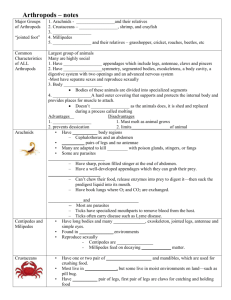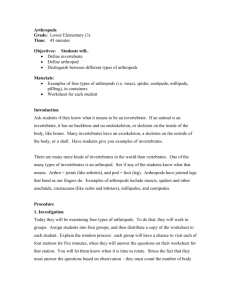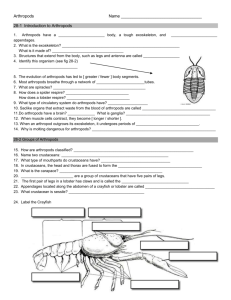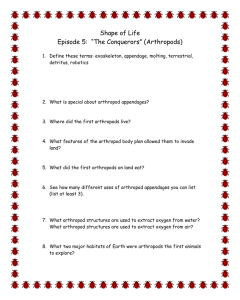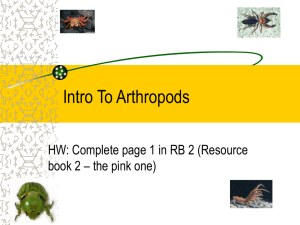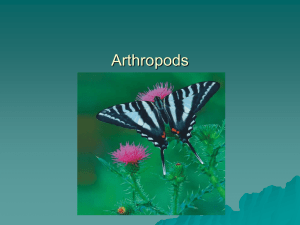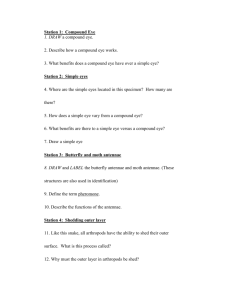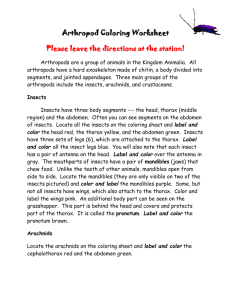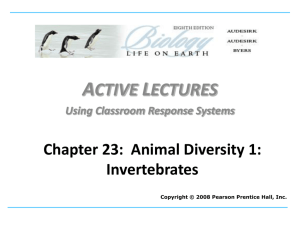Arthropods Station 2
advertisement
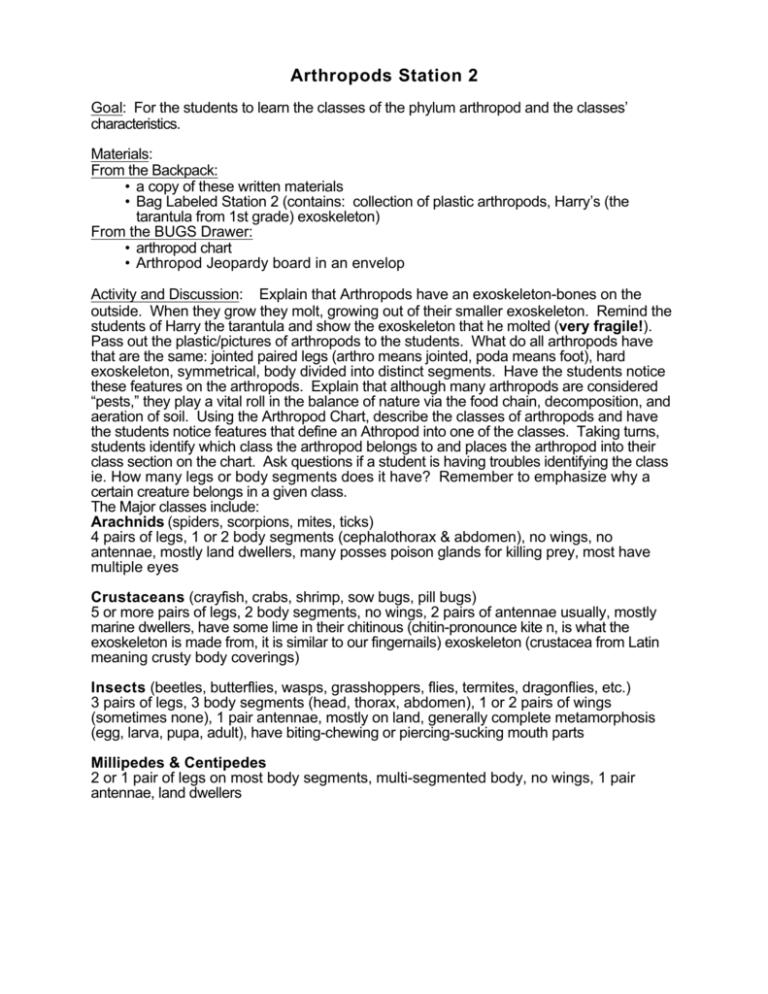
Arthropods Station 2 Goal: For the students to learn the classes of the phylum arthropod and the classes’ characteristics. Materials: From the Backpack: • a copy of these written materials • Bag Labeled Station 2 (contains: collection of plastic arthropods, Harry’s (the tarantula from 1st grade) exoskeleton) From the BUGS Drawer: • arthropod chart • Arthropod Jeopardy board in an envelop Activity and Discussion: Explain that Arthropods have an exoskeleton-bones on the outside. When they grow they molt, growing out of their smaller exoskeleton. Remind the students of Harry the tarantula and show the exoskeleton that he molted (very fragile!). Pass out the plastic/pictures of arthropods to the students. What do all arthropods have that are the same: jointed paired legs (arthro means jointed, poda means foot), hard exoskeleton, symmetrical, body divided into distinct segments. Have the students notice these features on the arthropods. Explain that although many arthropods are considered “pests,” they play a vital roll in the balance of nature via the food chain, decomposition, and aeration of soil. Using the Arthropod Chart, describe the classes of arthropods and have the students notice features that define an Athropod into one of the classes. Taking turns, students identify which class the arthropod belongs to and places the arthropod into their class section on the chart. Ask questions if a student is having troubles identifying the class ie. How many legs or body segments does it have? Remember to emphasize why a certain creature belongs in a given class. The Major classes include: Arachnids (spiders, scorpions, mites, ticks) 4 pairs of legs, 1 or 2 body segments (cephalothorax & abdomen), no wings, no antennae, mostly land dwellers, many posses poison glands for killing prey, most have multiple eyes Crustaceans (crayfish, crabs, shrimp, sow bugs, pill bugs) 5 or more pairs of legs, 2 body segments, no wings, 2 pairs of antennae usually, mostly marine dwellers, have some lime in their chitinous (chitin-pronounce kite n, is what the exoskeleton is made from, it is similar to our fingernails) exoskeleton (crustacea from Latin meaning crusty body coverings) Insects (beetles, butterflies, wasps, grasshoppers, flies, termites, dragonflies, etc.) 3 pairs of legs, 3 body segments (head, thorax, abdomen), 1 or 2 pairs of wings (sometimes none), 1 pair antennae, mostly on land, generally complete metamorphosis (egg, larva, pupa, adult), have biting-chewing or piercing-sucking mouth parts Millipedes & Centipedes 2 or 1 pair of legs on most body segments, multi-segmented body, no wings, 1 pair antennae, land dwellers Arthropods Page 2 Play Arthropod Jeopardy This game is based loosely on the Jeopardy television game show. To start, divide the students into two groups that will work together as a team. Decide which team will go first. The first team picks a category and point value. You uncover the question and read it aloud. Give the teams a few seconds to confer quietly among themselves to decide on an answer. If the first team answers the question correctly, they get the points. The second team then chooses a category and point value. If the first team has answered incorrectly, then the other team has the opportunity to answer the question and if the second team answers correctly they get the points. Regardless of who answers correctly the second team gets to pick the category and point value for the next round and gets to try to answer the question first. Continue to alternate teams getting to pick the category and point value and getting first try at the answer. Play the game until the time is up. Have fun with it and down play the points and competition, emphasize the learning of the classes of arthropods. Arthropods Jeopardy Game All answers are in the form of a question and will be either: What are insects?, What are arachnids?, What are crustaceans?, What are millipedes and centipedes?, or What are arthropods? Creepy Crawlies Beetles, butterflies and grasshoppers make up this class What are insects? Our class contains crabs, crayfish and sow bugs What are crustaceans? We are worm like creatures with hundreds of legs What are centipedes and millipedes? Some of us spin a web and wrap our food in a web What are arachnids? We creep and crawl in the water or on the land or some of us can fly in the air What are arthropods? Hard on the Outside Exoskeleton These arthropods are mostly found in water or sometimes in moist places What are crustaceans? They have many body segments with legs on most segments What are millipedes and centipedes? We have a hard exoskeleton that we molt in order to get bigger What are arthropods? They are made up of head, thorax and abdomen What are insects? These arthropods have two body segments (cephalothorax & abdomen) What are arachnids? Arthropods Page 3 What makes me Special We love the forest floor as we move with our many segmented body What are millipedes and centipedes? We go through metamorphosis: egg, larva, pupa and adult What are insects? Most of us have poison for killing our prey What are arachnids? Our legs come in pairs with joints. There are more species in our phylum than any other animal group What are arthropods? We have lime in our chitin that makes our exoskeleton What are crustaceans? Parts & Locomotion We have 8 legs, no wings, no antennae What are arachnids? We have no wings, 2 antennae, and many legs What are millipedes and centipedes? We have 6 legs, 2-4 wings and 2 antennae What are insects? We have 10 or more legs, no wings and four antennae What are crustaceans? Our bodies have distinct segments and are symmetrical What are arthropods?
